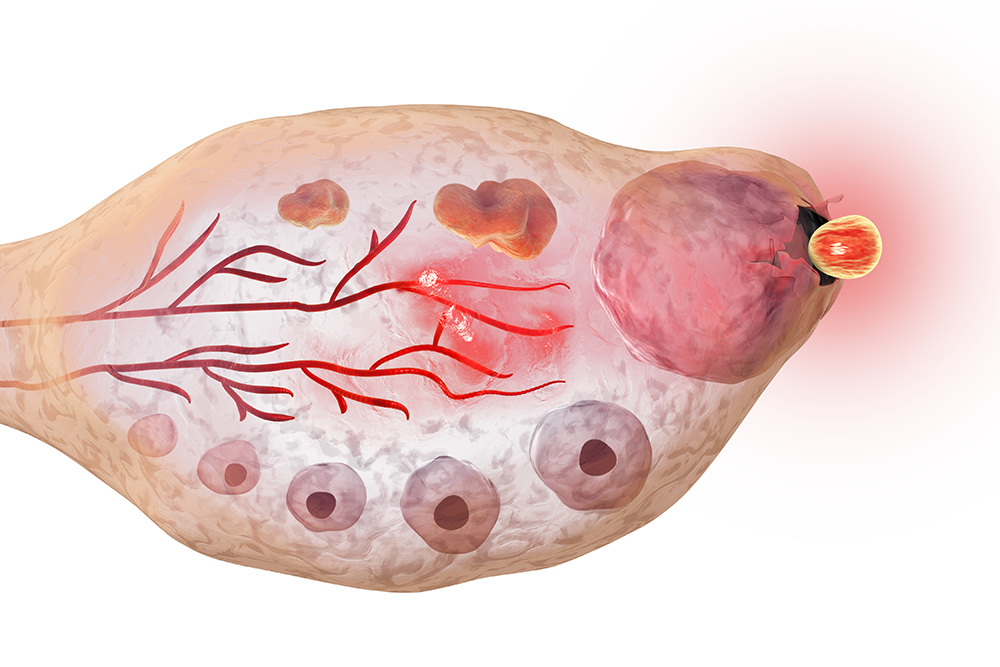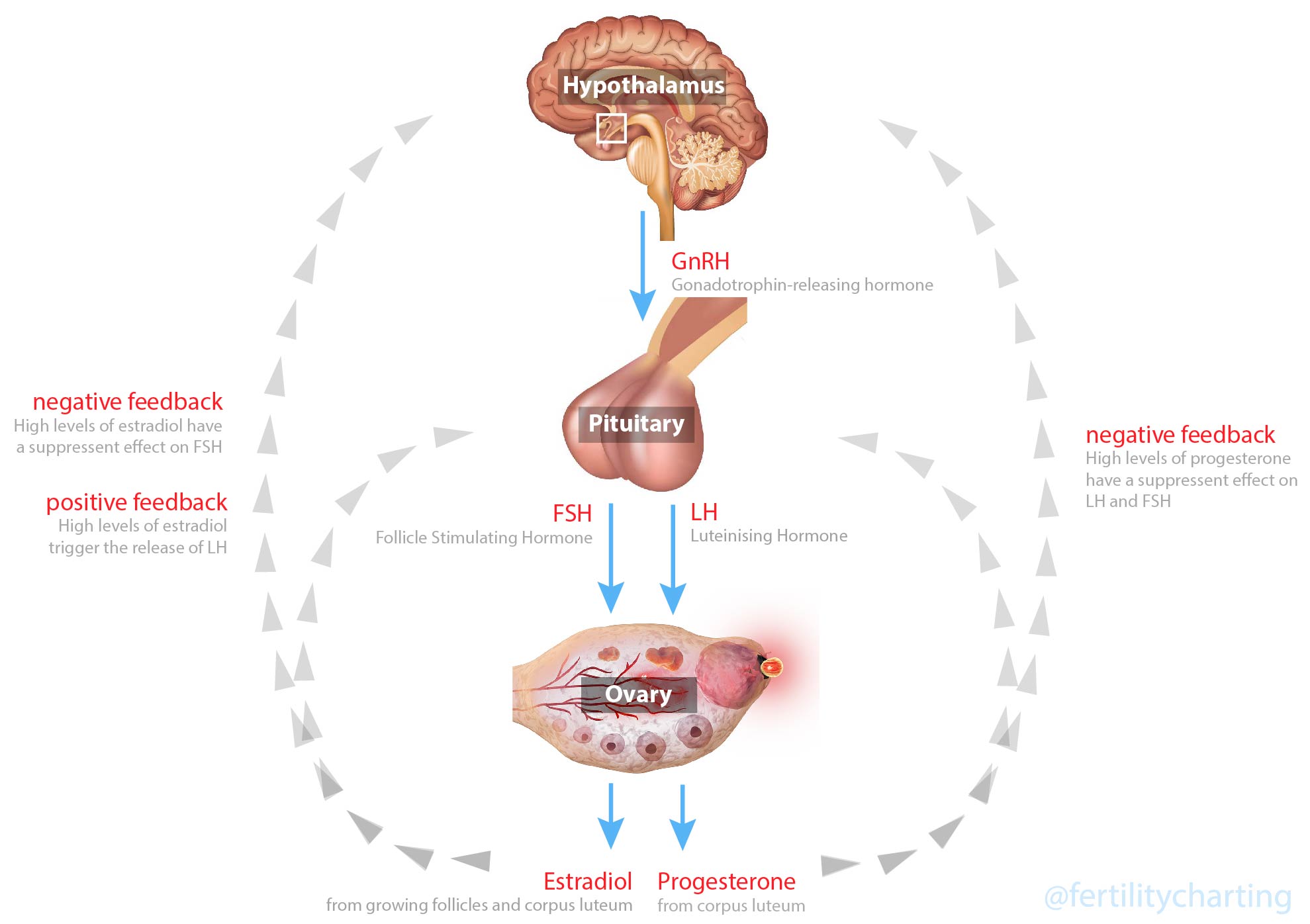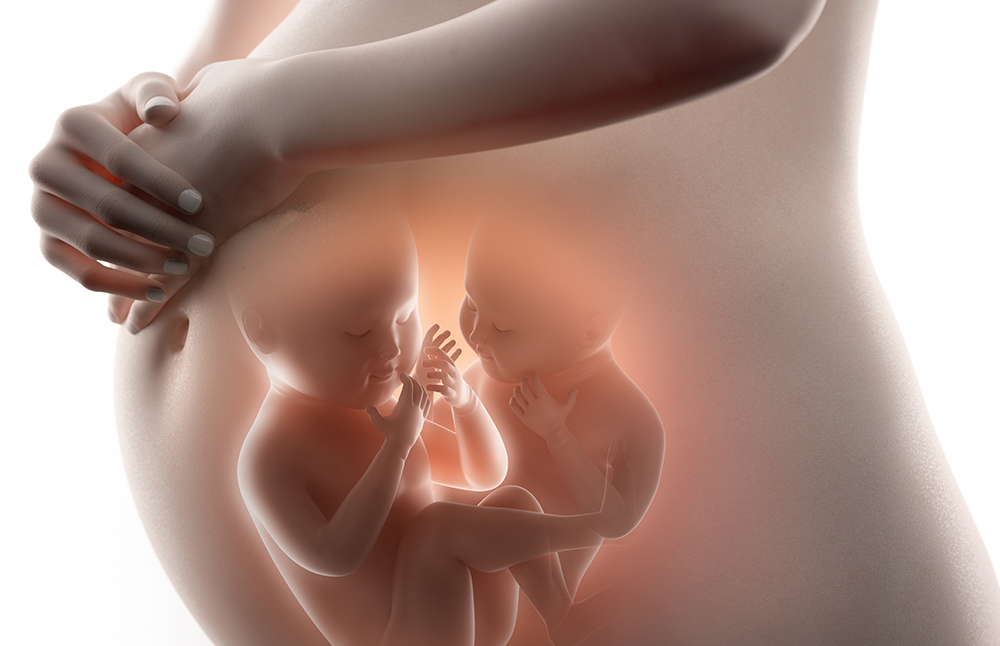“Can you spontaneously ovulate at different times throughout the menstrual cycle?”
It is a common question and the answer is thankfully no.
Our reproductive system actively stops us from ovulating on multiple occasions within a single menstrual cycle.
Ovulation is an event that occurs when a mature ovum bursts out of the follicle that houses it (simultaneously bursting out of the ovary, too). The human ovum has a lifespan of 12-24 hours, during which there is the possibility of the release of a second or third ovum – this is how fraternal twins/triplets are conceived. While multiple ova can be released during this 24 hours, this is still considered a single ovulation event. The lifespan of the human ovum means that a woman is fertile for a maximum of 48 hours every menstrual cycle (this does not take into consideration the lifespan of sperm).

The event of ovulation itself occurs around 24-36 hours after a surge in a hormone known as luteinising hormone (LH).
This surge of LH is released when the dominant follicle has grown large enough to secrete peak levels of oestrogen. Peak levels of oestrogen travel through the bloodstream to the hypothalamus, triggering it to release GnRH (gonadotrophin-releasing hormone) which causes the pituitary to deliver the surge of LH that triggers ovulation.
Once the ovum is released, the follicle that housed it develops into the corpus luteum – an endocrine gland around 2-5cm in diameter that secretes the hormone progesterone.
Progesterone has an inhibiting effect on the hypothalamus – it stops the release of further gonadotrophin-releasing hormone, which in turn means that the pituitary will not secrete any further LH. This means that even if subsequent follicles developed to a size large enough to secrete peak oestrogen levels, the pituitary is unable to trigger their release as it cannot secrete any further LH.
To summarise – once you have ovulated and the corpus luteum has formed – the ovaries are unable to release any further ova because progesterone in the bloodstream inhibits the secretion of LH from the pituitary gland.

If this is the case, why do so many people think you can ovulate randomly at multiple times during your menstrual cycle?
The widespread yet misinformed belief that a woman can ovulate on separate occasions within a single cycle, can be traced back to a journalism piece titled “Women can ovulate more than once a month” by Gaia Vince and published in the NewScientist in July 2003. (You can take a read of it here)
Throughout the editorial, Vince cited a scientific study called “A new model for ovarian follicular development during the human menstrual cycle” by Canadian researchers A.R. Baerwald, G.P. Adams and R.A. Pierson. Unfortunately, Vince blatantly misreported the actual scientific findings of the study – likely for the sake of media sensationalism.
In fact, the results of the study were so misconstrued (not just by Vince but by many other news outlets also) that the lead researcher Roger Pierson was compelled to agree to an interview with the University of Saskatchewan to clear up the confusion. The interview, published by Saskatchewan’s own on-campus news was titled “A cautionary tale about research that touches a nerve”. (You can take a read of it here.) In it, Pierson is quoted as saying “That story claimed women ovulate two or three times a month and that’s simply not true.”

So what did Roger Pierson’s study actually find?
It turns out that Pierson’s study supports the existing knowledge that a woman experiences a single ovulation event per menstrual cycle. However, it was discovered that during the menstrual cycle there are numerous waves of follicular growth (whereas previously it was thought that there was only one wave of follicular growth). Journalists all over the world decided to exchange the term “multiple waves of follicular growth” with “multiple ovulations” – two entirely different concepts!
As Pierson points out in his interview with the University of Saskatchewan, it is only the final wave of follicular growth within the ovary that actually results in ovulation – meaning women really do only experience one ovulation event per menstrual cycle after all.
But what about superfetation?

If you haven’t heard of superfetation I don’t blame you – it is extremely rare (a total of around ten reported cases in global history) and the scientific community generally states that further research is needed to either definitively prove or disprove its existence in humans. Superfetation refers to the condition whereby an animal becomes pregnant with another offspring, while already pregnant. This results in the mother carrying two offspring that are at different stages of development. If you’re interested in reading more about superfetation, the article “A review of the mechanisms and evidence for typical and atypical twinning” is a good place to start.
One theory for the mechanism of superfetation is that some women may have abnormally high levels of FSH (follicle stimulating hormone), which may resist the inhibitory effect of estradiol, progesterone and inhibin A during the first few days/weeks after implantation. Another theory is that some women may have a unique endocrine response to embryo implantation, resulting in levels of estradiol, progesterone and inhibin A that are too low to inhibit the release of FSH and LH from the pituitary. Both of these scenarios could result in an ovulation event after pregnancy has already occurred. You can read more about these mechanisms in the article “Unpredicted ovulations and conceptions during early pregnancy: an explanatory mechanism of human superfetation”
Conclusion? Superfetation remains to be definitively proven by science, and even if it were to be confirmed it is an extremely rare event that applies to pregnant women only.
The jury is in ladies and gents. Ovulation is an event that occurs once in a single menstrual cycle.
Curious about natural birth control? Join the mailing list!



I have been trying to get pregnant for 8 months now, and have been tracking my LH surges with opk test strips. I started testing everyday during the month because I was getting ovulation symptoms right after my period. So I found that I have a positive LH surge on cd 10, and then another LH surge on cd 17. And this has happened for the past 3 months I’ve tested everday. I still am not pregnant and I am curious why I am having two LH surges regularly. I have a regular 31 day cycle. And I have successfully had one child who is 16 months old. My body seems to be trying to ovulate making it a 28 day cycle, but then is unsuccessful and then I have another LH surge making it a 31 day cycle. Do you think my body trying to ovulate earlier is making it so I am not ovulating later with a healthy egg? I have been taking Vitex for a month now to try and regulate my ovulation. I am just confused what would cause a regular scheduled LH surge twice a month.
Hi Cherie,
Great question! If you’re trying to conceive, it is actually more important to be consistently checking your cervical mucus at every bathroom break (both before and after you void your bladder/bowels).
It’s important to try to time sex on days that you are experiencing a lubricative vaginal sensation and cervical mucus with the consistency of raw eggwhite (some women will experience a water content so high that this fluid can no longer be picked up and has a more watery consistency). These types of cervical fluid are known as “peak type” fluid as they are typically only present when oestrogen levels are peaking in your bloodstream.
It’s important to time sex on these days because cervical mucus is what prolongs the life of sperm. The vagina is naturally very acidic and quite inhospitable to sperm. When you are experiencing high-quality “peak type” cervical mucus, the lifespan of the sperm can be as long as up to 5 days in the reproductive tract. This gives sperm the best chance of being ready and waiting in your fallopian tubes for when your ovaries release an egg at ovulation.
A surge of luteinising hormone does not guarantee that ovulation will occur – it only signifies that your body is likely to try to ovulate within the next 24-36 hours (and it may very well fail). However, it’s important to know that studies show there is a variation among women as to when ovulation occurs in relation to the LH surge. For someone women, ovulation occurs right at the very beginning of an LH surge – meaning by the time they have tested and seen a positive, it is sometimes too late to have sex (as the human egg only lives a maximum of 24 hours, but usually much less). For this reason, it’s more important to have sex *before* ovulation occurs so that sperm can be ready and waiting in the reproductive tract. And tracking your cervical fluid is the best way of making this happen.
I recommend working with an instructor to track your cervical fluid – you can find one here: https://fertilitycharting.com.au/find-an-instructor/
If you’ve been charting your cycles diligently and having well-timed intercourse (based on cervical fluid and BBT) for six months, it would be warranted to visit a doctor and ask for testing. Don’t forget to have your partner tested too – up to 40-50% of fertility issues can be attributed to the male partner.
All the very best with your journey and I hope that this has helped!
Kind Regards,
Jessie Brebner
How about the concept you can ovulate again with the moon cycle you were born on?
Hi Zoe,
That’s a great question! There is no scientific evidence that supports spontaneous ovulation to occur on the phase of the moon that you were born on – indeed, if Natal Lunar Cycles were a valid scientific concept, then the Symptothermal Method (which has been proven up to 99.6% effective in clinical trials) would not be a valid form of contraception.
I have a resource planned to release on Natal Lunar Cycles and how they have no scientific basis and this is scheduled for the next few months.
Stay tuned!
Kind Regards,
Jessie
My menstruation came on 29th of June, I felt a sharp pain on the left side of my abdomen on 12th of July which l believe is a sign of ovulation.l had that same sharp pain on 16th of July,same month.
My question is this; can the second pain be a sign of ovulation too? ls it possible for me to ovulate two times in a circle?
Hi Blessing,
This is a great question! Ovulation pains are officially known as “mittelschmerz” (German for “middle pain).
Mittelschmerz is a secondary fertility sign – that is, it’s influenced by our reproductive cycle but it doesn’t provide a level of information that would allow us to pinpoint any events on our chart. You cannot confirm ovulation by feeling mittelschmerz.
The reason for this is that mittelschmerz doesn’t necessarily occur right at the moment of ovulation. In fact, mittelschmerz can last for a few hours up to about 5 days (with 12-24 hours being the norm). The pain is usually felt on the side of ovulation.
It’s hypothesised that mittelschmerz could be caused by a number of things, including:
🌧 Pressure on surrounding abdominal structures due to the growth of follicles in the surface of the ovary – the dominant follicle normally grows to around 2cm in diameter.
🌧 Abdominal irritation due to the release of blood and follicular fluid when the follicle ruptures to release the ovum.
🌧 Contractions of the fallopian tube as it transports the ovum toward the uterus.
On top of this, it’s very easy to confuse other types of pain (such as gas pains, digestion issues, constipation or ovarian-cyst pressure) for mittelschmerz. So it is not a reliable fertility indicator.
If you read the article above, you will see that it is not possible to ovulate at two different times in a single menstrual cycle. Ovulation is a hormonal event that lasts for 24 hours only. During this 24 hours more than one egg can be released, but outside of this 24 hours, no further eggs can be released.
I hope this is helpful for you. If you’re interested in tracking your fertility using the Symptothermal Method please see the “Find-An-Instructor” page.
Kind Regards,
Jessie
Hi! I want to thank you for this information. I’ve been very confused about the ovulatory possibilities of my body, and haven’t found, until now, clear material to get to understand it. Again, thank you!
I wonder if this text has been translated into Spanish. I’d love to share it with Argentinian readers.
Hi Julieta,
Thank you for replying! I’m so glad this article is helpful for you.
As far as I know it has not been translated – have you tried using Google to translate this webpage? Maybe that will help!
Kind Regards,
Jessie
Thank you for your answer Jessie! I sent you an email!
I thought it was unlikely, but possible, to ovulate twice within 24 hours? Did you find any evidence supporting or weakening that belief?
Hi Teresa,
Great question, thanks for reaching out! I actually address this in the first few paragraphs, and will copy paste the wording here:
Ovulation is an event that occurs when a mature ovum bursts out of the follicle that houses it (simultaneously bursting out of the ovary, too). The human ovum has a lifespan of 12-24 hours, during which there is the possibility of the release of a second or third ovum – this is how fraternal twins/triplets are conceived. While multiple ova can be released during this 24 hours, this is still considered a single ovulation event.
I hope this helps, but let me know if you need more information 🙂